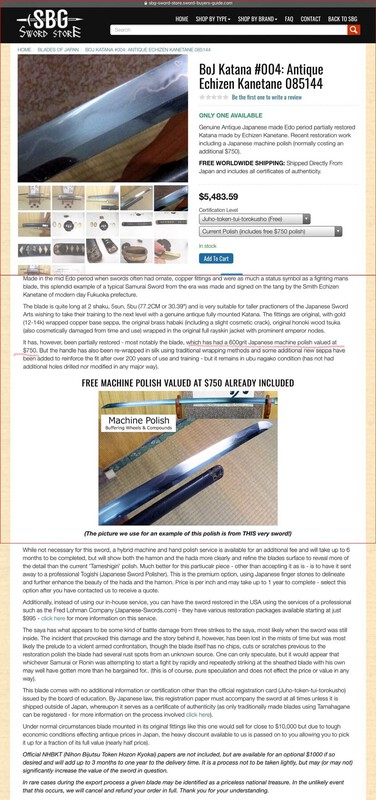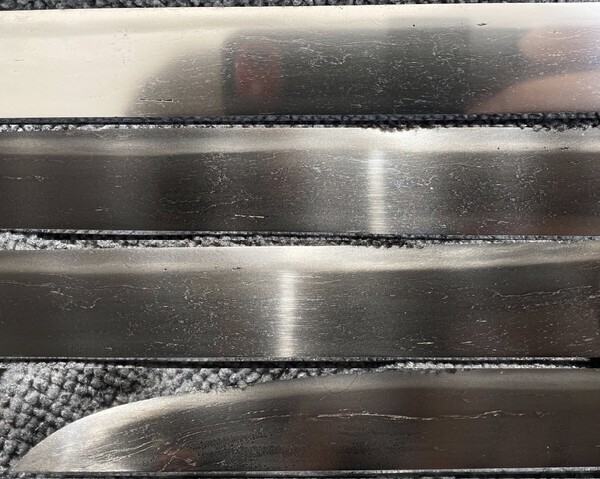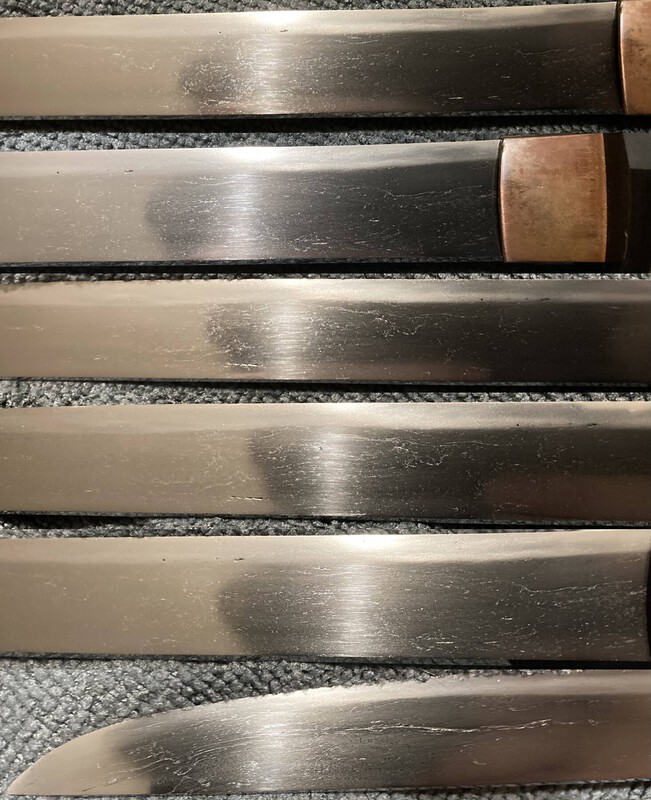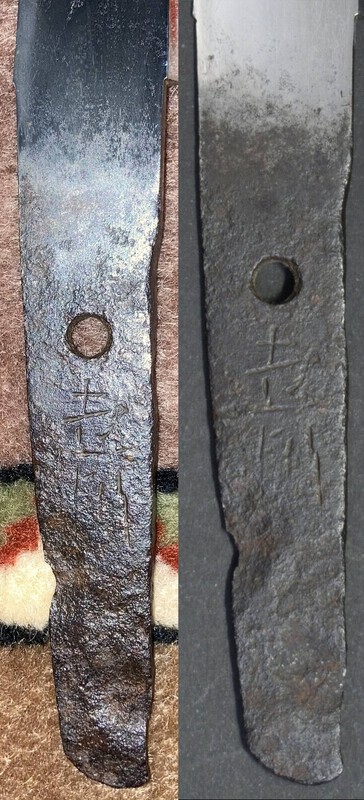-
Posts
253 -
Joined
-
Last visited
-
Days Won
1
Content Type
Profiles
Forums
Events
Store
Downloads
Gallery
Everything posted by AntiquarianCat
-
I know I’ve said the best thing to do when people do bad practices like amateur polishing is to deny them exposure, but this is a big sword site amongst millennials and genZ so regardless of what I do, it already has massive exposure, plus they rejected all private criticism and went full speed ahead in promoting sandpaper polishes as a way to cheaply and safely restore nihonto. Anyways SBG which sold replicas and gave advice regarding them is branching out to selling nihonto, when I heard I thought that was fantastic since a lot of new people might get into this hobby... Even if it turned out they were mostly just selling lower end stuff for huge markups(green papered swords for 30K is steep). Then I found out they sandpaper polish their nihonto. Like this (formerly) nice hefty looking blade: in their own words it was in reasonable polish, had a very minor inactive surface rust problem and instead of using a less destructive way of removing, they took a 600 grit sandpaper machine and gave it a “polish” and called that a free restoration. It gets worse since all their other swords are trying to upsell the buyer into buying sandpaper machine polishes or machine-hybrid polishes (acid using I think). They are telling people that trust them to pay them top dollar for sandpapering their antiques, that it will improve them. It just seems shady and like something that will forever put off new people from the hobby when they buy one of their blades and realize the “restoration” did irreversible damage and loss of value. Also, thanks to presenting themselves as experts many people will now think you restore antique swords with sandpaper and acid.
-
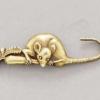
Consignments-with-us Selling fakes
AntiquarianCat replied to Bruce Pennington's topic in Auctions and Online Sales or Sellers
Yes you are right, and that’s why it would be a mistake to drag this forum into that battle. I should have thought of that. That said angry blacklisted eBay sellers would constantly charge into Ancient Coins about how they were being “slandered”, or write letters, and in turn were handed dossiers documenting all the patently fake coins they sold as legitimate. Perhaps it’s because Ancient Coins is based in the states and if your opinion is credible enough it’s something they can’t sue for here (and we have anti libel tourism laws) why they could get away with a blacklist. -

Consignments-with-us Selling fakes
AntiquarianCat replied to Bruce Pennington's topic in Auctions and Online Sales or Sellers
It looks like it sold and they gave someone a shoddy fake advertised as real despite knowing full well they were selling a fake, absolutely disgraceful behavior. Forum Ancient Coins has a notorious fake sellers list that big eBay sellers can earn their way into if they repeatedly and knowingly sell counterfeits. I wonder if people like this one would deserve to be included in a similar list. It certainly is needed for ancient coins since many fraudsters have quite good eBay ratings and would otherwise get away with it if not called out. It seems like that’s the case with swords too. -
I mean no disrespect but I feel the sword was somewhat underrated. I mean sure the hamon and hada aren’t as elegant as a Juyo art sword’s, but it’s a small fraction of the cost, in polish, full of a ton of activities and seems to be a well made example of a working sword from the period so if you’re a newer collector what’s not to like? I think it’s a good piece for newer people. Think it would make a nice, rugged looking study piece and really wonder what exactly it would paper as?
-
I’m not qualified to tell you, but about your last purchase? Can you get your money back? Ebay has a clause where if an item is misrepresented (and the seller won’t do a voluntary return) they can force the seller to refund and give him a defect. Merely an unstated implication of going that route was enough to get a seller that concealed an acid wash/amateur polish and chipped kissaki to take back my buy. If they outright lied and sold you a cheap fake it’ll be even easier to force a refund I’m sure. Also moral of the story from my mistake: unless you’re an expert, never buy a sword when the seller won’t give you closeup photos of key sites, them promising it’s okay isn’t enough. Else you risk getting a very disappointing surprise.
-
Looking at that wiki page, I think they made a mistake by choosing a couple of non traditional acid etched examples. Not only are the acid eaten patterns unnatural and ergo a bad demonstration of grain, but they also use Japanese terms like mokume which might lead new people to think that’s what a hada looks like. Ergo the new people will be at the mercy of scammers that sell them stuff like this. Edit: it was probably too strong a word to call the Wiki images shoddy fakes, I was curious why that was the WP example of Japanese smithing, looked it up and found the smiths are self taught American knife makers. I’m sure they’re talented (in fact their tanto replicas look very good) but they absolutely aren’t using traditional methods and that isn’t what hada should look like. I can’t see any nioiguchi either. This is why you can’t always trust Wikipedia. I’m not sure if somebody should edit that page on Japanese smithing by replacing the non traditional replica with an actual example of Mokume. In the future Jaime, if you see that tie dye Damascus hada pattern, run away since it’s a surefire sign of non traditional and most making such things are much less competent than the knife guys.
-
I’m sorry if my tone didn’t seem right, I was going for levity. I don’t think you have anything to apologize for, everyone makes mistakes and luckily for you they happened with replica swords. If you want to start reading I would say to look at Usagiya. It’s a great reference site and they have many pictures of what real swords look like http://www.ksky.ne.jp/~sumie99/index.html
-
Every cloud has a silver lining and the happy lining here is that you don’t need to worry about that acid wash just this one time: don’t get me wrong the pitting and steel corrosion acid will do, which can never be fully fixed, is a terrible way to lose thousands were it an antique. The reason you don’t need to worry this one time is as everyone noted: these are cheap replicas so little of value was lost. In the future, if you see that weird tyedie etched looking “Damascus” hada, along with things like that misshapen kisaki, stay away since those are the hallmarks of poorly made acid etched replica. Seriously though, when you get a nihonto, stay away from acid and abrasives since that’s a very easy way to cut its value to a fraction.
-
I’m not sure it’s such a good idea too keep linking to his monetized videos: people get paid for every click so giving him views, hate views even, will encourage that idiot and help him buy more victims. It’s the same dilemma as when friends warn me about YouTube videos where people mistreat animals, as much as an outrage that is, unless you’re going to brigade to report those videos for tos violations (even if they might not technically be violating tos) so that they get demonetized, nothing will be gained by giving those bad people exposure. Granted destroying a fine sword isn’t quite as bad but I still think it better the guy doing this remain obscure.
-
My photography skills are still very poor. Especially when it comes to using lenses in professional cameras so I’m sure that is why the proportions are unfortunately so inconsistent. I gave up and just started using my phone from longish distances to minimize distortion. I had no idea professional polishes are so expensive but I suppose that’s no surprise given the great difficulty of the task. I guess the first thing to do would be to have it sent for shinsa. Then it would be possible to decide if to try a polish. One thing that worries me though is that the wretched habaki is still stuck and I worry the blade could be rusting under it. I’m not sure if whatever dealer would send it for a shinsa could remove it as part of the service. I don’t know if some choji should be applied to sink in there and halt potential rusting. Regarding curvature my impression is that this blade’s curvature at the nakago created by osuriage is a continuation of the curvature that was already present in the blade, it makes me feel the gradual curvature would have continued in at least some of the missing part.
-
I suppose I’m even more confused now since I had previously been told it didn’t look Kanbun on account of the relatively little taper, elongated kisaki, and what it would have looked like prior to osuriage. It doesn’t look that much like the Kanbun piece, I have. That said the Kanbun Owari examples I looked through have some that look robust -more than this blade- with large kisaki but they have much more curvature (even the example you shared is nearly the same length but with nearly double curvature), before osuriage this one would seem to have been significantly longer(and likely at a length above the allowed at the time), and the hada, hamon and boshi look quite different. I guess the Kanbun Owari examples I’ve been shown remind me of short Keicho and Kanei blades.
-
Thank you, I’m still new to this so if you could explain what fumbari means in this case? I had thought that was the flaring out of swords at their hamachi so any trace of that would have been lost by osuriage. I guess what threw me off is that this sword doesn’t have the sakisori or taper I’ve seen from longer muromachi pieces. Could this one have been designed as a tachi and that is why at first glance it’s not shaped like those? I suppose the safest thing might be to try to send it for a shinsa first. It seems a polish is even more costly than I thought.
-
I hope I’m not causing trouble by asking a few questions and making an update but I’d like to do something with this sword: Firstly, and most importantly, if I wanted it polished and sent for shinsa, would the best course be to contact someone like Robert Benson and ask for more information? And would I be right in assuming a polish would be at least about 3000$, if not more? And secondly, since people more knowledgeable than me suggested it this blade might be in the Yamato tradition and Koto, would it be reasonable to guess it might be from a tradition like Shikake? I’ve been looking at oshigata and swords and things like its hamon and the nagare seem similar. Would some point in the nanbokucho (or it being in that style) be a reasonable period of manufacture? It certainly feels more substantial, with less taper than the pre sengoku muromachi example I have. Also I’m pretty surprised at how ignorant I was in this thread: after handling several other swords from different periods I can say this one has much higher shinogi than the actual Kanbun example, or the rest of them for that matter. It’s almost a diamond cross section compared to the sengoku katate-uchi and the Kanbun.
-
I think it would be pretty helpful if you could post an overhead photo of your sword like the examples I posted. It would make it easier to see its shape than those angled photos.
-
I’m useless at mei so I’m not going to try, but I can say if your sword is muromachi it’ll have sakisori (sword curves late into the blade) like these two. Since you don’t have a top down photo and I’m using a phone it’s hard for me to tell but it looks like your sword has it, and also might be pretty curved so even if the signature is fake it could be muromachi, maybe even from the same general time period.
-

my satsuma blade might be older than the mounts
AntiquarianCat replied to micah's topic in General Nihonto Related Discussion
I would wager that most of the soldiers participating in the rebellion brought their family blades, or used weapons seized from the arsenals so no reason to expect them to be in terrible shape. As for Arsenal weapons like Kazu-uchi-mono, there are many that despite being by smiths known to make them, and having the signatures associated with being a bundle sword, still are polished and in good shape. Arsenal weapons can look nice. Or maybe that’s just me since I’m weird and think a lot of katate-uchi, probably even some mass produced ones look nice. -

my satsuma blade might be older than the mounts
AntiquarianCat replied to micah's topic in General Nihonto Related Discussion
I apologize if my suggestion was poorly worded. I never suggested using uchiko on what’s left of the nakago. I thought it might be worth a try on the blade itself. They say it’s permissible to uchiko swords that are mostly or totally out of polish so long as you do it with the right methods. It helped with a sword I was told wasn’t worth a polish, I could barely see the hada asides from some patches that were more in polish and after two years of periodically using Robert Benson’s uchiko, the hada is more visible and you can even make out jinie. Of course it’s your sword so it was just a foolish suggestion on my part so don’t worry about it. If you mean the blade itself though, I haven’t heard of a Japanese blade being out of polish referred to as patina. I think that’s more of a term I have heard used with old knives and European blades. -
It looks like it has a lot of nie. I thought that was only something you could get with water quenched swords made in traditional or similar to traditional methods. The kisaki looks nice as well. If it is a counterfeit then does this mean whoever is making these has gotten so good as to make their forgeries with what were the hallmarks of traditionally made blades? Bad news if that is the case.
-

my satsuma blade might be older than the mounts
AntiquarianCat replied to micah's topic in General Nihonto Related Discussion
I’m not sure, I think Usagiya has examples of swords where they filled in black rust pits with red urushi. And my understanding is that those were old patches on old scars so surely they all would have fallen out if patina were ungluable. I have to agree with Chris. There are 1970s shinsakuto with more patina than the naked parts of your nakago. And I doubt glue would have kept it from repatinating in the century and a half since it’s filing. Unless Saigo Takamori was secretly importing Renaissance wax and using it as glue for filed nakagos the cleaning couldn’t have been so old and look so new. Isn’t it possible that this sword and its glued together fittings could have been done after ww2, for a tourist or something? That would explain why so little patina has regrown. Also I still think it might be worth using high quality uchiko. Maybe it’s possible the hamon isn’t gone and the reason it’s indiscernible is because the sword is just that badly out of polish. It certainly wouldn’t get it back in polish but maybe it might make the hamon a tad more visible. -

my satsuma blade might be older than the mounts
AntiquarianCat replied to micah's topic in General Nihonto Related Discussion
Thank you Dave, that term is a great deal less confusing. To be honest, I’m fond of Satsuma Koshirae, so I was a bit disappointed when I clicked and found out the Satsuma mounts mentioned in this thread referred to jury-rigged fittings. And Micah, seeing as how the blade is so badly out of polish, maybe it wouldn’t hurt to use high quality uchiko here? It might make the hamon a bit more visible. Seeing as how there’s no signature and the nakago has been filed clean, that might be the only way to get more information. For what it’s worth I don’t think it’s a muromachi katate-uchi: the examples I’ve seen have a wider mihaba and they have sakisori. -

hard to watch video
AntiquarianCat replied to French nihonto's topic in General Nihonto Related Discussion
I bet whatever acid he used to strip the patina off the shakudo couldn’t have been good for his health. Also the translator says his video description said “The more I polished it, the more it ended up looking like a toy sword”. I hope this means he realizes he made a mistake. -

my satsuma blade might be older than the mounts
AntiquarianCat replied to micah's topic in General Nihonto Related Discussion
Hello Micah, I’m sort of confused as to why you call it a satsuma sword. If you mean the koshirae, it doesn’t look like this has the two holes you would expect from a Satsuma tsuba. It doesn’t look much like a lot of the very fine examples of Satsuma koshirae out there https://yuhindo.com/ishiguro-masayoshi-koshirae/ Did you mean you think the mounts are from the Satsuma Rebellion and that is why they appear crude? If you mean the blade, the following traits are what you could expect from Satsuma work but your sword is too out of polish for such things to be discernible. As friendly advice from one beginner to another, I’d like to say that you’re better off by starting with swords that are in decent polish. It takes collectors with a lot more experience than either of us to size up swords in poor condition and guess on if they’re worth a restoration. Better to hang on to your money for stuff you’ll like more I think. -
Thank you very much for your help. By Uda do you mean this blade might have been made by the Uda school? Markus did write about how two Uda school smiths from the late Muromachi (Bunmei and Tenbun) signed their works with Yoshikuni. That would fit in with the period of manufacture you estimated. Also, I’m not sure if I should be worried that my attempts at attribution are never right. I mistakenly thought this was an early shinto blade from Chikugo. Now that I think about it, the nakago seems much more worn and mineralized than other shinto examples I have so that should have been a clue. It seems that I can buy a ton of books, but at the end of the day I probably should try to attend more shows and get more experience at looking.
-
Here are a few more photos in case if they're of any use. If it helps there are higher quality versions of the collage photos here: https://app.photobucket.com/u/OddAntiquarian/p/e94fcf21-8438-4e09-a398-a0cbb845181d https://app.photobucket.com/u/OddAntiquarian/p/951503ea-6246-494e-b7cd-51e79845ee46 https://app.photobucket.com/u/OddAntiquarian/p/cb4a00e9-394b-4386-a42d-c9c36cbbfff3
-
So one of the daggers from my collection appears to be signed Yoshikuni and I’m not sure if it’s Gimei or worth trying to take to a shinsa. my understanding is that its mokume hada with nie patches and some coarsish masame is consistent with what Nagayama and Markus Sesko wrote about Chikugo Yoshikuni blades in their books and so is the konie suguha hamon with its odd dimple at the start of the monouchi... Then again, I’ve had an acid “polished” sword under my nose without noticing it had acid damage so clearly I need all the help I can get. If people would be kind enough to weigh in, could you all tell me if this blade seems consistent with Chikugo and the swords by the Yoshikuni line of smiths, and if it would be worth trying to bring this to a shinsa?


